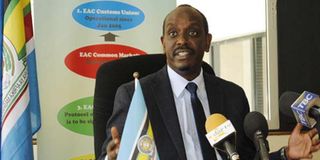EAC Customs Territory coming?

The EAC secretary general, Dr Richard Sezibera, said this was among his five priorities when he joined the regional organisation in 2011 and that he hoped its fruition was just around the corner. PHOTO|FILE
What you need to know:
- The Commissioner General of the Kenya Revenue Authority (KRA), Mr John Njiraini, made the remarks which appeared to allay disenchantment on the part of Tanzania and Burundi, the other EAC partner states which are not within the Coalition of the Willing.
Arusha. The Customs Territory, a trilateral arrangement by Uganda, Rwanda and Kenya, will be harmonised within the wider East African Community (EAC) Single Customs Territory, it was observed here at the weekend.
The Commissioner General of the Kenya Revenue Authority (KRA), Mr John Njiraini, made the remarks which appeared to allay disenchantment on the part of Tanzania and Burundi, the other EAC partner states which are not within the Coalition of the Willing.
He told a meeting of the EAC Committee of Customs that the revenue authorities in all the five partner states were still committed to the integration process, particularly the implementation of the Single Customs Territory (SCT).
“The initiatives under the trilateral arrangement by Uganda, Rwanda and Kenya will be harmonised within the wider EAC Single Customs Territory,” he told the meeting at the Community headquarters.
EAC Customs director Kenneth Bagamuhunda noted that the Single Customs Territory was one of the key regional integration priority policy interventions adopted by both the Council and the Summit to consolidate the EAC Customs Union.
He said it was imperative that the revenue authorities took full responsibility “to ensure the Single Customs Territory is fully implemented as per the approved road map by the Council”.
The Committee established five technical working teams that will put in place operational requirements and procedures for the envisaged Customs arrangement.
The meeting also agreed on the schedule of activities for the implementation of the tool.
According to a dispatch from the EAC Secretariat, the pilot- based approach segmented on the central and northern corridors was adopted which will progressively cover all goods cleared at the first ports of entry.
The meeting agreed to integrate the ongoing activities on SCT on the Northern Corridor into the EAC wide SCT framework. A proactive, practical and result-based method of work was agreed on as a way of working on the SCT.
Recently the EAC announced that implementation of the SCT framework would begin this year as directed by the Heads of State Summit recently.
The EAC secretary general, Dr Richard Sezibera, said this was among his five priorities when he joined the regional organisation in 2011 and that he hoped its fruition was just around the corner.
“
I look forward to its implementation beginning 2014. We’ve seen significant and sustained removal of non-tariff barriers to trade -- and the results thereof are beginning to be felt by East Africans,” he said in his New Year message sent to the media houses.
During its 15th Ordinary Summit in Kampala, Uganda on November 30th last year, the EAC leaders directed that the SCT should commence on January 1st and be operationalised by June 2014.
Prior to the summit, a report on the framework on the operalisation, which was finalised recently, was presented and adopted by the EAC Council of Ministers, the policy organ of the Community.
Dr Sezibera said with the blessings of the Summit, he was confident that the new customs arrangement would be implemented by all the partner states without unnecessary delay.
The Single Customs Territory aims to liberalise trade within the region as goods would circulate freely within the territory, which is not the case at present.
Analysts believe the EAC still suffers internal controls which have hindered the region from getting full benefits of a customs union.
Under the SCT, the bloc will have a common legal framework that would ensure free circulation of goods with minimal or no border controls.
Implementation of the framework would also lead to harmonisation of standards from goods moved through the territory, inter-connected payment system and collection of customs duties at the first point of entry.
The study on SCT commenced in September 2011 and was undertaken by Adam Smith International and MA Consulting Group and aimed to lead the region to realize appropriate institutional and legal framework for unified customs services.
Dr Sezibera added that free movement of persons and labour provisions of the Common Market Protocol will be boosted by an agreement on the use of Identity Cards as travel documents within EA by Burundi, Kenya, Rwanda, and Uganda beginning this year.
“This will also be the year we finalise all preparations and Procure the Next generation Internationalised East African Passport which will be issued in 2015,” he explained.




